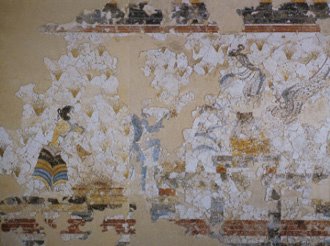
I'm just a busy bee! Here's another section I've added to the Wikipedia article on the Minoans. It suggests that women ruled. Wanna take bets on how long it'll take the Wiki Police to shoot down this one? Someone already deleted it yesterday; I put it back on today:
"In Minoan art, women vastly outnumber men (see archaeologists Goodison and Morris, 1998, p. 115). Women are often shown seated on thrones, and in commanding positions. Women are often saluted by people and/or animals. Whereas depictions exist of men showing deference to women, not one shows women deferring to men. Unlike every one of their contemporaries, all of whom possessed obvious “strong-man” male rulers, the Minoans show almost no trace of male rule at all.
"Archaeologist Jacquetta Hawkes says'The absence of … manifestations of the all-powerful male ruler that are so widespread at this time and in this stage of cultural development as to be almost universal, is one of the reasons for supposing that the occupants of Minoan thrones may have been queens' (p. 76). 'In the scenes from the seal stones, not only is the Goddess always the central figure, being served and honored in a variety of ways; she is sometimes shown seated on a throne. Supposing that a king did rule as consort of the Goddess, one would expect at the very least that at the royal court, which elsewhere, in Egypt and the Orient, was seen as the human reflection of the divine order, there would have been a throne for the queen as the counterpart of the Goddess. Yet in the sacred room at Knossos, and apparently also in the state apartment in the residential quarter, the throne stood single and alone.' (Hawkes, 1968, P. 154.)"Like Egyptian rulers, Minoan queens may have had divine status:'… [I]t is not impossible that Minoan Crete was run by women…. [I]n the so-called Camp Stool Fresco from Knossos, which depicts [people] sitting on stools and toasting each other, the principal figure (known as La Parisienne since the days of Evans) is painted twice the size of the others – a clear sign of importance and probably of divinity, to judge from Egyptian art, where the divine pharaoh is regularly shown in this way' (Cadogan 1992: 37).'The predominance of female forms [in Minoan art] is striking,' say archaeologists Goodison and Morris (Goddison and Morris p. 115)…. “Is there … perhaps a hint of modern sexual asymmetry in interpretations which now admit males to the world of [Minoan] divine power, but still exclude females from temporal power, distancing them in the realm of the transcendent as goddesses or priestesses?' (p. 130)."In short, more evidence exists supporting Minoan rule by women than rule by men."
1 comment:
YOU GO, GIRL! Why don't you write a post to get people to come to the GoGoddess yahoo group? You have a friendlier mix than I in your readers...
Post a Comment